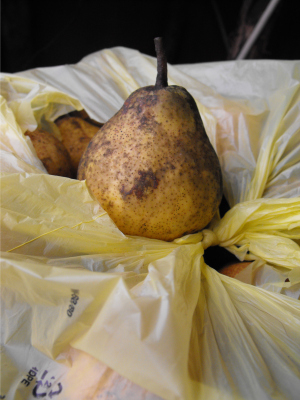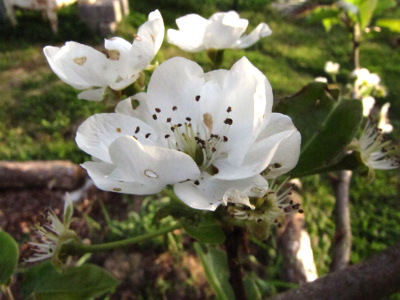
Disease-resistant pear varieties
 The
fifth chapter of The
Holistic Orchard is
about pome fruits --- apples, pears, and quinces. Of these,
quinces seem to be very prone to fire blight damage, and I've posted
about disease-resistant
apple varieties
previously, so I thought I'd sum up Phillips' (and Lee Reich's) tips on choosing
resistant pears.
The
fifth chapter of The
Holistic Orchard is
about pome fruits --- apples, pears, and quinces. Of these,
quinces seem to be very prone to fire blight damage, and I've posted
about disease-resistant
apple varieties
previously, so I thought I'd sum up Phillips' (and Lee Reich's) tips on choosing
resistant pears.
Although they're both
called pears, European pears (Pyrus
communis) and
Asian pears (Pyrus
pyrifolia, Pyrus
ussuriensis, plus
other crosses) are different beasts. Asian pears can fruit in
year 3 (versus year 8 to 10 for most European pears), but European
pears come into their own as prime keeping fruits, some of which can
last all winter in your root cellar. Most relevantly, though,
Asian pears are much less resistant to fire blight (the worst disease
to affect pears in the U.S.), with the only semi-resistant varieties
I've heard about being:
- Korean Giant (aka Olympic) --- ripens in late October and keeps four months
- Shinko --- the most blight-resistant Asian pear, ripening in
September to October
- Yoinashi --- an early (August-ripening), somewhat
blight-resistant pear
 Among European pears, you
have a much greater selection of blight-resistant varieties. In
the table below, I've summed up the ones that look most promising here
in zone 6, with a focus on flavor. As you can see, if you focus
on harvest and storage times, you could be eating homegrown pears from
August through December (or later).
Among European pears, you
have a much greater selection of blight-resistant varieties. In
the table below, I've summed up the ones that look most promising here
in zone 6, with a focus on flavor. As you can see, if you focus
on harvest and storage times, you could be eating homegrown pears from
August through December (or later).
| Variety |
Zone |
Ripening
time |
Notes |
| Atlantic Queen |
5 to 8 |
September |
deals well with adverse
conditions |
| Ayers |
6 to 8 |
early August |
partially self-pollinating |
| Blake's Pride |
4 to 8 |
September |
bears young; good pollinator;
stores 4 months |
| Burford |
6 to 8 |
September |
semi-dwarf |
| Harrow Delight |
4 to 8 |
mid August |
|
| Harvest Queen |
September |
||
| Luscious |
4 to 8 |
mid September |
|
| Magness |
5 to 9 |
early September |
flavor is reputed to be
excellent; althogh leaves and flowers are resistant, trunk is
susceptible to fire blight; slow to bear; needs pollinizer; keeps 4
months |
| Maxine |
4 to 8 |
mid September |
aka Starking Delicious |
| Moonglow |
5 to 8 |
early August |
bears early; keeps 4 months |
| Potomac |
5 to 9 |
late September |
slow to bear; Anjou-type pear |
| Seckel |
5 to 8 |
September |
flavor is reputed to be
excellent; semi-dwarf (8 to 10 feet tall); keeps 3 months; can get
blight, although somewhat resistant |
| Shenandoah |
mid to late September |
more acidic than an average
pear; stores 4 months |
|
| Tyson |
5 to 8 |
late August |
tastes like Seckel |
| Warren |
5 to 8 |
late August |
low yields and needs pollinator;
stores 4 months |
I'd love to hear some firsthand data from our readers. Which pear varieties have you planted? Have they lived up to your expectations?
Next Wednesday, we'll be discussing chapter 6, which sums up all of the luscious stone fruit (peaches, apricots, etc.) If you're new to the book club, you might also want to check out previous posts on beginning a holistic orchard, techniques for designing a holistic orchard, orchard soil health, and managing fungi in the orchard. And be sure to chime in on yesterday's post about the future of the book club.
Want more in-depth information? Browse through our books.
Or explore more posts by date or by subject.
About us: Anna Hess and Mark Hamilton spent over a decade living self-sufficiently in the mountains of Virginia before moving north to start over from scratch in the foothills of Ohio. They've experimented with permaculture, no-till gardening, trailersteading, home-based microbusinesses and much more, writing about their adventures in both blogs and books.
Want to be notified when new comments are posted on this page? Click on the RSS button after you add a comment to subscribe to the comment feed, or simply check the box beside "email replies to me" while writing your comment.

I’ve got a 4-way (fruit salad) European pear from Raintree nursery in Washington. The 4 varieties I have are Harrow Delight, Highland, Rescue and Orcas. Some are early, others later, a couple are to be keepers. I’ve had the tree two years. I’m not sure if it would have bloomed this year, but in Michigan this year we had a very warm Jan and Feb (into the 80s!) followed by a freeze down to 23F (with lots of wind). Even though I had everything covered, my peach (Redhaven) lost all its blossoms.
At a previous home, I had two dwarf apples (also from Raintree), but fighting off pests wasn’t worth the effort of repeating at the new home. I’ve heard it is difficult to grow organic apples except in large blocks where any pests stop at the outside rows. It is extremely difficult if there are old neglected apples (such as in a subdivision like I am) providing breeding grounds for new pests. I had some luck covering individual apples with small paper bags, but eventually accepted some maggots, and just ate them with a paring knife.
Thanks for the book series. I’ve been reading along (although often after your posts).
You are in a similar climate to me (Arkansas Ozarks, zone 6b/7), though you are slightly wetter and cooler it seems, and it always makes your posts so relevant! Our fruit trees have only been in the ground a year so I don't have personal experience to add. However, our local orchardist has been growing apples and pears for more than 20 years and also works for NCAT (National Center for Appropriate Technology) as a Horticulture Specialist. He sells at our farmer's market and is a blast to talk to, so dynamic and dapper. His recommendations for our climactic challenges are here:
http://amesorchardandnursery.com/pears.html
I know I have tried some of those varieties you have listed, not sure which ones without my notes, but seckle made the cut.
Seckle is actually very resistant to fireblight. A very tasty pear, like eating flowers. It was my first pear.
A very tasty pear, like eating flowers. It was my first pear.
I grow a few pears, and they all seem to be more or less resistant to FB. Orient Floridahome LeConte Keiffer Southern Barlett Are all the ones I have, but they are not all keepers. I'm working out the less desirable ones.
I don't know why you list ayers pear as a resistant pear. It has always given me more problems than any other I've planted including Bartlett. Even using the proper sprays and etc, nothing works.